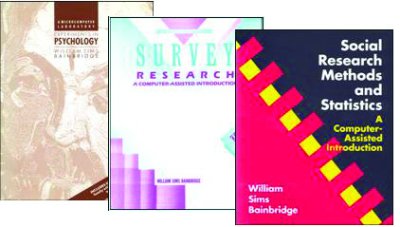Strategies for Personality Transfer
William Sims Bainbridge
page 2 of 15

Image 1: Books by Bainbridge
More importantly, the project included a program for constructing, administering, and analyzing simple questionnaires. I created a more complex program of the same kind for my 1989 textbook, Survey Research[1] and developed analysis tools for my 1992 textbook, Social Research Methods and Statistics[2]. In the mid-1990s, I explored methods for using the World Wide Web to create culturally grounded personality-archiving questionnaires containing thousands of items.[3,4]
As part of a team supported by the National Geographic Society, I incorporated an open-ended question about the future a century from now in the online questionnaire, Survey 2000. Approximately 20,000 people responded, and from their responses I culled 2,000 distinct predictions that became the items in a personality-capture software module called The Year 2100. A person is asked to rate each prediction in terms of how good it would be if it happened, and how likely it is that it will. The Year 2100 has three main goals. It seeks to be:
- An interactive book of the future based on the thoughts of thousands of people around the world, thus a time machine for the imagination.
- A system for recording a person’s opinions about issues that challenge decision makers today, thus a time capsule to preserve an important aspect of that individual.
- An educational system for preparing essays concerning the major trends of our times, thus a method for consciousness expansion at both home and school.
Analysis can measure the person’s optimism in twenty areas of life, construct the individual’s utopia of great things unlikely to occur, and achieve other insights about the particular person. Ten other similar software modules have brought the total to 22,000 stimuli with two responses each for 44,000 personality measurements. I programmed an updated version of one of my 1986 modules to chart a person’s short-term memory, STM. Another system called ANNE (ANalogies in Natural Emotions) has the person rate 4,000 standard events in terms of 20 emotions, for another 80,000 measurements, and then do the same for 1,000 episodes from the person’s own life [5]. Figure 1 lists the 13 software programs created to date.
Figure 1: Personality Capture Modules from the Bainbridge Laboratory
|
Name |
Area |
Items |
Status |
|
The Year 2100 |
Predictions of the future |
4,000 (2 × 2,000) |
Released |
|
Beliefs |
Agree-disagree statements |
4,000 (2 × 2,000) |
Released |
|
Beliefs II |
Agree-disagree statements |
4,000 (2 × 2,000) |
Released |
|
Wisdom |
Agree-disagree statements |
4,000 (2 × 2,000) |
Released |
|
Emotions |
Situations that might elicit one of twenty common emotions |
4,000 (2 × 2,000) |
Released |
|
Experience |
Experiences a person may have |
4,000 (2 × 2,000) |
Released |
|
Taste |
Preferences for foods |
4,000 (2 × 2,000) |
Released |
|
Association |
Judgments of the connections between pairs of words |
4,000 (2 × 2,000) |
Released |
|
Action |
Preferences for various actions |
4,800 (2 × 2,400) |
Released |
|
Self |
Adjectives describing oneself |
3,200 (2 × 1,600) |
Released |
|
Self II |
Public domain surrogates for standard psychology measures |
4,000 (2 × 2,000) |
Beta testing |
|
ANNE |
Emotional reactions to events |
100,000 (20 × 5,000) |
Under development |
|
STM |
Capacity of short-term memory |
5,760 (48 × 120) |
Experimental |
To understand what work still needs to be done, we should undertake an inventory of both the facets of personality that need to be captured and existing methods to do so. To conduct my inventory, I will rely upon a rough classification of personality variables suggested by Robert R. McCrae and Paul T. Costa.[6] Although there is much one could debate about it, the classification is a useful checklist of aspects of personality that different researchers and theorists have highlighted in the past. More recent attempts to classify aspects of personality deserve consideration in any serious attempt to develop measures for personality transfer, but this schema provides a useful structure for purposes of this essay.[7,8] As shown in Figure 2, it is organized in terms of five basic categories: basic tendencies, characteristic adaptations, self-concept, objective biography, and external influences.
Figure 2: Five Categories of Personality Variables
|
Category |
Sub-Category |
|
Basic tendencies |
Genetics |
|
Characteristic adaptations |
Acquired competencies |
|
Self-concept |
Implicit & explicit views of self |
|
Objective biography |
Overt behavior |
|
External influences |
Developmental influences |
Footnotes
1. Bainbridge, William Sims. 1989. Survey Research: A Computer-Assisted Introduction Belmont, California: Wadsworth.
(back to top)
2. Bainbridge, William Sims. 1992. Social Research Methods and Statistics. Belmont, California: Wadsworth. (back to top)
3. Bainbridge, William Sims. 2003. “Massive Questionnaires for Personality Capture,” Social Science Computer Review, 21(3): 267-280; (back to top)
4. Bainbridge, William Sims. 2004. “The Future of the Internet: Cultural and Individual Conceptions.” Pp. 307-324 in Society Online: The Internet in Context, edited by Philip N. Howard and Steve Jones. Thousand Oaks, California: Sage. (back to top)
5. Bainbridge, William Sims. 2006. “Cognitive Technologies.” Pp. 203-226 in Managing Nano-Bio-Info-Cogno Innovations: Converging technologies in Society, edited by William Sims Bainbridge and Mihail C. Roco. Berlin: Springer, 2006.
(back to top)
6. McCrae, Robert R., and Paul T. Costa, “Toward a New Generation of Personality Theories.” Pp. 51-87 in The Five-Factor Model of Personality, edited by Jerry S. Wiggins (New York: Guilford, 1996). (back to top)
7. Mayer, John D. 2004. “A Classification System for the Data of Personality Psychology and Adjoining Fields,” Review of General Psychology, 8: 208-214. (back to top)
8. Mayer, John D. 2005. “A Tale of Two Visions: Can a New View of Personality Help Integrate Psychology?” American Psychologist, 60: 294–307. (back to top)